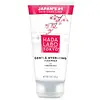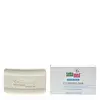What's inside
What's inside
 Key Ingredients
Key Ingredients

 Benefits
Benefits

 Concerns
Concerns

 Ingredients Side-by-side
Ingredients Side-by-side

Sodium Cocoyl Glycinate
CleansingGlycerin
HumectantCocamidopropyl Betaine
CleansingButylene Glycol
HumectantPotassium Cocoyl Glycinate
Hydroxypropyl Starch Phosphate
Decyl Glucoside
CleansingPEG-400
Emulsion StabilisingWater
Skin ConditioningSodium Lauroyl Aspartate
CleansingBHT
AntioxidantCitric Acid
BufferingDisodium EDTA
Glyceryl Stearate Se
EmulsifyingHydroxypropyl Methylcellulose
Emulsion StabilisingHydroxypropyltrimonium Hyaluronate
Lauric Acid
CleansingMethylisothiazolinone
PreservativeMica
Cosmetic ColorantPEG-32
HumectantPhenoxyethanol
PreservativePolyquaternium-7
Polyquaternium-52
Sodium Acetylated Hyaluronate
HumectantSodium Stearoyl Glutamate
CleansingStearic Acid
CleansingTitanium Dioxide
Cosmetic ColorantSodium Cocoyl Glycinate, Glycerin, Cocamidopropyl Betaine, Butylene Glycol, Potassium Cocoyl Glycinate, Hydroxypropyl Starch Phosphate, Decyl Glucoside, PEG-400, Water, Sodium Lauroyl Aspartate, BHT, Citric Acid, Disodium EDTA, Glyceryl Stearate Se, Hydroxypropyl Methylcellulose, Hydroxypropyltrimonium Hyaluronate, Lauric Acid, Methylisothiazolinone, Mica, PEG-32, Phenoxyethanol, Polyquaternium-7, Polyquaternium-52, Sodium Acetylated Hyaluronate, Sodium Stearoyl Glutamate, Stearic Acid, Titanium Dioxide
Disodium Lauryl Sulfosuccinate
CleansingPalmitic Acid
EmollientStearic Acid
CleansingTriticum Vulgare Starch
AbrasiveGlyceryl Stearate
EmollientCetearyl Alcohol
EmollientTalc
AbrasiveWater
Skin ConditioningSodium Lauroyl Sarcosinate
CleansingCocamidopropyl Betaine
CleansingParfum
MaskingInulin
Skin ConditioningLecithin
EmollientCera Alba
EmollientTocopheryl Acetate
AntioxidantGlycine
BufferingMagnesium Aspartate
Skin ConditioningAlanine
MaskingLysine
Skin ConditioningLeucine
Skin ConditioningCI 77891
Cosmetic ColorantDisodium Lauryl Sulfosuccinate, Palmitic Acid, Stearic Acid, Triticum Vulgare Starch, Glyceryl Stearate, Cetearyl Alcohol, Talc, Water, Sodium Lauroyl Sarcosinate, Cocamidopropyl Betaine, Parfum, Inulin, Lecithin, Cera Alba, Tocopheryl Acetate, Glycine, Magnesium Aspartate, Alanine, Lysine, Leucine, CI 77891
Ingredients Explained
These ingredients are found in both products.
Ingredients higher up in an ingredient list are typically present in a larger amount.
Cocamidopropyl Betaine is a fatty acid created by mixing similar compounds in coconut oil and dimethylaminopropylamine, a compound with two amino groups.
This ingredient is a surfactant and cleanser. It helps gather the dirt, pollutants, and other impurities in your skin to be washed away. It also helps thicken a product and make the texture more creamy.
Being created from coconut oil means Cocamidopropyl Betaine is hydrating for the skin.
While Cocamidopropyl Betaine was believed to be an allergen, a study from 2012 disproved this. It found two compounds in unpure Cocamidopropyl Betaine to be the irritants: aminoamide and 3-dimethylaminopropylamine. High-grade and pure Cocamidopropyl Betaine did not induce allergic reactions during this study.
Learn more about Cocamidopropyl BetaineStearic Acid is a fatty acid. It is an emollient, emulsifier, and texture enhancer.
As an emollient, stearic acid helps soften skin. It aids the skin's protective barrier by preventing water loss. It also provides a gentle cleansing effect without stripping away natural oils.
Stearic acid may also be used to enhance the texture of products. It can add volume and stabilize ingredients such as water and oil. This can help water and oil ingredients from separating.
Sources of stearic acid include animal or vegetable fats/oils such as coconut or shea. It can be naturally found in butter, cocoa butter, shea butter, vegetable fats, and animal tallow.
This ingredient may not be Malassezia folliculitis, or fungal-acne safe.
Learn more about Stearic AcidWater. It's the most common cosmetic ingredient of all. You'll usually see it at the top of ingredient lists, meaning that it makes up the largest part of the product.
So why is it so popular? Water most often acts as a solvent - this means that it helps dissolve other ingredients into the formulation.
You'll also recognize water as that liquid we all need to stay alive. If you see this, drink a glass of water. Stay hydrated!
Learn more about Water